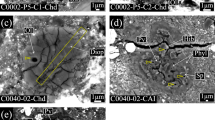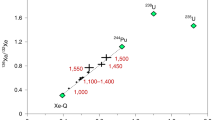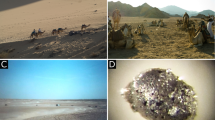Abstract
CARBONACEOUS chondrites such as the Allende meteorite are composed of abundant ferromagnesian chondrules and (Ca, Al)-rich inclusions (CAIs) embedded in a fine-grained matrix. The chondrules were formed by melting of pre-existing solid precursor materials1, whereas CAIs formed either by direct condensation from the nebular gas or by high-temperature processing of solids in the nebula2. These two components usually appear as discrete objects in chondrites, and are believed3 to have formed independently before agglomeration of the chondrite parent bodies. However, elemental analyses of some Al-rich chondrules4–8 suggest that there was a refractory component—such as CAIs—in the chondrule precursor material. We report here the discovery of a ferromagnesian chondrule from the Allende meteorite that contains an intact CAI fragment. This finding confirms that some CAIs coexisted with the precursor material of ferromagnesian chondrules, and helps to constrain the timing of the formation events of these two components.
This is a preview of subscription content, access via your institution
Access options
Subscribe to this journal
Receive 51 print issues and online access
$199.00 per year
only $3.90 per issue
Buy this article
- Purchase on Springer Link
- Instant access to full article PDF
Prices may be subject to local taxes which are calculated during checkout
Similar content being viewed by others
References
Grossman, J. N., Rubin, A. E., Nagahara, H. & King, E. A. in Meteorites and the Early Solar System (eds Kerridge, J. F. & Matthews, M. S.) 619–659 (Univ. Arizona Press, Tucson, 1988).
Grossman, L. A. Rev. Earth planet. Sci. 8, 559–608 (1980).
Wood, J. A. A. Rev. Earth planet Sci. 16, 53–72 (1988).
Wark, D. A. Geochlm. cosmochim. Acta 51, 221–242 (1987).
Rubin, A. E. & Wasson, J. T. Geochim cosmochim. Acta 51, 1923–1937 (1987).
Rubin, A. E. & Wasson, J. T. Geochim. cosmochim. Acta 52, 425–432 (1988).
Misawa, K. & Nakamura, N. Geochim. cosmochim. Acta 52, 1669–1710 (1988).
Misawa, K. & Nakamura, N. Nature 334, 47–50 (1988).
McSween, H. Y. Jr Meteoritics 20, 523–540 (1985).
Sheng, Y. J., Hutcheon, I. D. & Wasserburg, G. J. Geochim. cosmochim. Acta 55, 581–599 (1991).
Wark, D. A. & Lovering, J. F. Lunar Sci. VII, 912–914 (1976).
Palme, H. & Wlotzka, F. Earth planet. Sci. Lett. 33, 45–60 (1976).
El Goresy, A., Nagel, K. & Ramdohr, P. Proc. 9th Lunar planet. Sci. Conf., Geochim. cosmochim. Acta suppl. 10, 1279–1303 (1978).
Blander, M., Fuchs, L. H., Horowitz, C. & Land, R. Geochim. cosmochim. Acta 44, 217–223 (1990).
Fegley, B. Jr & Palme, H. Earth planet. Sci. Lett. 72, 311–326 (1985).
Sylvester, P. J., Ward, B. J., Grossman, L. & Hutcheon, I. D. Geochim. cosmochim. Acta 54, 3491–3508 (1990).
Hewins, R. H. in Meteorites and the Early Solar System (eds Kerridge, J. F. & Matthews, M. S.) 660–679 (Univ. Arizona Press, Tucson, 1988).
Lofgren, G. E. & Lanier, A. B. Geochim. cosmochim. Acta 54, 3537–3551 (1990).
Anders, E. & Grevesse, N. Geochim. cosmochim. Acta 53, 197–214 (1989).
Wark, D. A. Astrophys. Space Sci. 65, 275–295 (1979).
Bischoff, A. & Palme, H. Geochim. cosmochim. Acta 51, 2733–2748 (1987).
Blum, J. D., Wasserburg, G. J., Hutcheon, I. D., Beckett, J. R. & Stolper, E. M. Nature 331, 405–409 (1988).
Allen, M. J., Grossman, L., Davis, A. M. & Hutcheon, I. D. Proc. 9th Lunar planet. Sci. Conf., Geochim. cosmochim. Acta suppl. 10, 1209–1233 (1978).
MacPherson, G. J. & Grossman, L. Geochim. cosmochim. Acta 48, 29–46 (1984).
MacPherson, G. J., Bar-Matthews, M., Tanaka, T., Olsen, E. & Grossman, L. Geochim. cosmochim. Acta 47, 823–839 (1984).
Kuehner, S. M. & Grossman, L. Lunar planet. Sci. XVIII, 519–520 (1987).
MacPherson, G. J., Grossman, L., Allen, J. M. & Beckett, J. R. Proc. Lunar planet. Sci. 12B Geochim. cosmochim. Acta suppl. 16, 1079–1091 (1981).
Wark, D. A. Lunar planet. Sci. XII, 1145–1147 (1981).
Author information
Authors and Affiliations
Rights and permissions
About this article
Cite this article
Misawa, K., Fujita, T. A relict refractory inclusion in a ferromagnesian chondrule from the Allende meteorite. Nature 368, 723–726 (1994). https://doi.org/10.1038/368723a0
Received:
Accepted:
Issue Date:
DOI: https://doi.org/10.1038/368723a0
This article is cited by
-
Fragments of history preserved
Nature (1994)
Comments
By submitting a comment you agree to abide by our Terms and Community Guidelines. If you find something abusive or that does not comply with our terms or guidelines please flag it as inappropriate.



